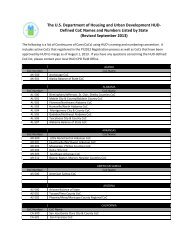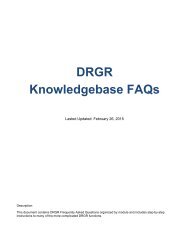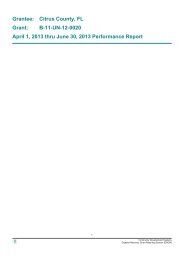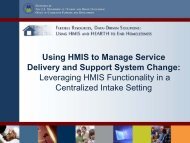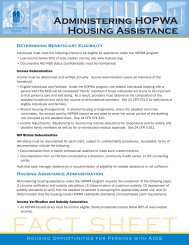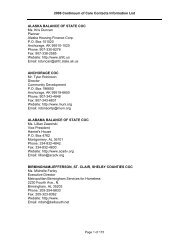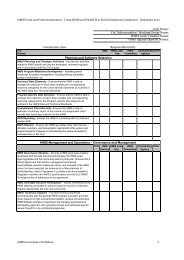<strong>HMIS</strong> <strong>Project</strong> <strong>Management</strong> <strong>Topics</strong> <strong>and</strong> <strong>Tools</strong>The project manager can prepare for these risks in advance by developing a risk plan that detailsthe potential risks, the likelihood of the risk occurring, the impact an occurrence would have,actions to avoid the risk, <strong>and</strong> contingency plans if the problem occurs (see Appendix 10).Proactive tasks to avoid risks that are deemed highly likely or highly damaging should be addedto the project plan. Thus, if staff turnover is highly likely <strong>and</strong> will cause a high impact, thencross-training team members should be added to the project plan.<strong>Tools</strong> for Managing a <strong>Project</strong> PlanThere are a variety of software tools that help project managers manage time, resources, quality<strong>and</strong> scope. Most often, these software tools use Gantt charts to schedule tasks (scope), theanticipated length of each task (time), <strong>and</strong> staff <strong>and</strong> monetary resources. They can also enableusers to indicate dependencies of one task on another. Quality is more difficult to quantify, but isoften a function of the other three variables.Microsoft <strong>Project</strong> is the most widely used project management software on the market <strong>and</strong> isused by several <strong>HMIS</strong> managers around the country. The software costs between $600 <strong>and</strong>$1500, depending on the version, <strong>and</strong> is full of features that may be very useful to advancedproject managers <strong>and</strong> overwhelming <strong>and</strong> too complex for others.A listing of alternative software tools, including several that are free, can be found athttp://www.columbia.edu/~jm2217/ For example, Open Workbench(http://www.openworkbench.org/) advertises itself as an open source, free alternative toMicrosoft <strong>Project</strong>. A brief description of about 13 software tools can be found athttp://commercial-solutions.com/pages/pmsoftware.html. More in-depth reviews of theseproducts, conducted by <strong>Project</strong> Manager Today magazine can viewed, for a nominal price, athttp://www.pmtoday.co.uk/pm_software.asp.Most <strong>HMIS</strong> project managers contacted for this document used Microsoft Excel to manage theirbasic tasks, budgets <strong>and</strong> staff assignments. They found Excel adequate for most of theiractivities, even though it does not have built-in project management features to manage taskdependencies or indicate whether staff members are over-allocated. Some managers resorted toExcel even after training <strong>and</strong> experience with Microsoft <strong>Project</strong>. Others, however, have not beenexposed to anything else <strong>and</strong> might not be aware of the potential benefits of off-the-shelf projectmanagement tools.Maintaining Policies <strong>and</strong> ProceduresIt is critical for every <strong>HMIS</strong> implementation to develop, adopt, maintain, <strong>and</strong> enforce st<strong>and</strong>ardoperating procedures (SOPs). Policies <strong>and</strong> procedures generally address privacy protectionagreements, how data will be stored <strong>and</strong> protected, who is responsible for its protection, whichdata can/cannot be shared, <strong>and</strong> how it will be done. The Final Notice includes baseline privacy<strong>and</strong> security st<strong>and</strong>ards, <strong>and</strong> it also allows the options for communities to adopt stricter st<strong>and</strong>ardsas necessary. Thus, SOPs should work within the framework provided by the Final Notice toincorporate optional requirements as necessary based on a community vision of how the <strong>HMIS</strong>should operate. A project manager may also need to create other documents such as a privacy20
<strong>HMIS</strong> <strong>Project</strong> <strong>Management</strong> <strong>Topics</strong> <strong>and</strong> <strong>Tools</strong>notice <strong>and</strong>/or Client Consent Form for clients that may wish to share data with another agency,an Interagency Sharing Agreement, <strong>and</strong> Data Release Forms. These should be created inaccordance with the Final Notice as well as other federal <strong>and</strong> state privacy laws, <strong>and</strong> MIS bestpractices.Developing SOPsThe <strong>HMIS</strong> Implementation Guide (2002) 2 contains a chapter on St<strong>and</strong>ard Operating Procedures<strong>and</strong> Protocols. The chapter on SOPs contains information on several important elements thatshould be included in a SOP manual. They include: privacy protection protocols to ensure theconfidentiality <strong>and</strong> safety of sensitive information <strong>and</strong> to protect consumers, developing partneragreements in order to enforce compliance among system partners, <strong>and</strong> initial <strong>and</strong> ongoingtraining. The chapter also contains information about achieving data accuracy by conductingrespectful client interviews, by outlining minimal data elements so that there is consistency indata collection <strong>and</strong> by training data entry staff. Other resources on developing st<strong>and</strong>ard operatingprocedures are listed in Appendix 1.Updating Policies <strong>and</strong> Procedures<strong>Project</strong> managers should review SOPs at least once per year. More frequent revisions may berequired based on regulatory, policy, software, technology, or other local changes. A primeexample of a regulatory-prompted change is that project managers with previously adopted SOPsneed to work with their communities to update them to meet the requirements of the FinalNotice. The Final Notice contains baseline st<strong>and</strong>ards as well as more stringent optionalst<strong>and</strong>ards. A reasonable first step for project managers with existing SOPs to ensure complianceis to create a spreadsheet of each of the specific minimal requirements described in the FinalNotice, <strong>and</strong> a column to indicate the community’s policy in that area, <strong>and</strong> whether the policyneeds to be revised. For those that need to be revised, the project manager should suggestrevisions <strong>and</strong> devise action steps for revising the SOPs <strong>and</strong> implementing the changes.Figure 4.1 shows the beginning of a template for mapping SOPs to the st<strong>and</strong>ards in the FinalNotice. Note that some sections include several rules. Also, policies only need revision if thecurrent SOPs do not address the area or are more lenient than required by the Final Notice.2 http://www.hud.gov/offices/cpd/homeless/hmis/implementation/implementation.cfm21




